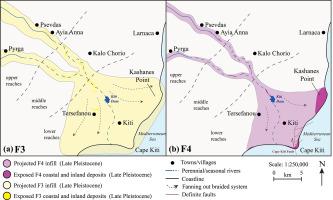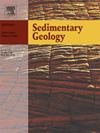塞浦路斯东南部Tremithos河的中晚更新世至全新世沉积物和相关的浅海至非海相海岸沉积物:相互关联的地表隆起和冰川-上升控制的海平面变化的产物
IF 2.9
2区 地球科学
Q1 GEOLOGY
引用次数: 0
摘要
Tremithos河的更新世发育体现了河流和浅海沉积的相互作用控制。整体驱动力是塞浦路斯南部的圆顶隆起,主要集中在蛇绿岩的Troodos地块。中-上更新世河流沉积主要受冰川-隆起及相关气候变化的影响。早-中更新世以残面和圆形侵蚀丘的形式保存下来。晚更新世—全新世出现了脉冲切口,河道加深、变窄,主要集中在上游。在中游形成了曲流。在下游形成的一种宽而浅的河道,进入海岸平原和广阔的三角洲,受周期性海侵和海退的影响在切割事件之后,在凉爽潮湿的气候下,粗糙、分选差的砾岩在高能水流下堆积,通常与冰期有关。河道填充物主要是由半辫状河道中较持久、较低能量的水流以及河岸上的沉积实现的。在一条约30公里长的河流中,常见的高抗性岩性(如燧石岩)的绕井表明,一些较老的阶地沉积物进行了再循环。白垩崩积:由附近白垩和泥灰岩的坡损形成的白垩崩积,主要在凉爽、潮湿时期形成。红色红土古土壤主要记录了相对温暖、稳定、湿润的时期。基岩岩性(如辉绿岩、燧石岩)对碎屑岩性和形状有很大影响。较年轻的河流沉积与沿海地区全新世浅海陆源沉积物和碳酸盐(包括孤立珊瑚)是同一时期的。一些先前报道的浅海砂被重新解释为风成砂。局部沉积受沿近海岸走滑断层的地表隆起影响,与非洲-欧亚板块的斜辐合有关。本文章由计算机程序翻译,如有差异,请以英文原文为准。

Middle-Late Pleistocene to Holocene sediments of the Tremithos River and related shallow-marine to non-marine coastal deposits in SE Cyprus: Products of inter-related surface uplift and glacio-eustatic controlled sea-level change
The Pleistocene development of the Tremithos River exemplifies interacting controls of fluvial and shallow-marine sedimentation. The overall driver was domal uplift of southern Cyprus, focused on the ophiolitic Troodos Massif. Middle-Upper Pleistocene fluvial sediments accumulated under the dominant influences of glacio-eustatic and related climatic changes. Early-Middle Pleistocene is preserved as remnant surfaces and rounded erosional hills. Late Pleistocene-Holocene saw pulsed incision that deepened and narrowed the channel, mainly in the upper reaches. Meanders developed in the middle reaches. A broad, shallow channel formed in the lower reaches, passing into a coastal plain and a broad delta, affected by cyclical marine transgressions and regressions. Following incision events, coarse, poorly sorted conglomerates accumulated under high-energy stream flow in a cool, wet climate, generally correlated with glacial periods. Channel fill was mainly achieved by more persistent, lower energy stream flow in semi-braided channels, coupled with overbank deposition. Common well-rounding of highly resistant lithologies (e.g. chert) within a c. 30 km-long river suggests some recycling from older terrace deposits. Chalky colluvium formed by slope wasting of nearby chalk and marl, mainly during cool, humid periods. Reddish terra rossa paleosols mainly record relatively warm, stable, humid periods. Bedrock lithologies (e.g. diabase, chert) exerted a strong influence on clast lithology and shape. Younger fluvial deposits are coeval with Holocene shallow-marine terrigenous sediments and carbonates (including solitary coral) in coastal areas. Some previously reported shallow-marine sands are reinterpreted as aeolianites. Locally, deposition was influenced by surface uplift along a near-coastal strike-slip fault, related to oblique convergence of the Africa-Eurasia plates.
求助全文
通过发布文献求助,成功后即可免费获取论文全文。
去求助
来源期刊

Sedimentary Geology
地学-地质学
CiteScore
5.10
自引率
7.10%
发文量
133
审稿时长
32 days
期刊介绍:
Sedimentary Geology is a journal that rapidly publishes high quality, original research and review papers that cover all aspects of sediments and sedimentary rocks at all spatial and temporal scales. Submitted papers must make a significant contribution to the field of study and must place the research in a broad context, so that it is of interest to the diverse, international readership of the journal. Papers that are largely descriptive in nature, of limited scope or local geographical significance, or based on limited data will not be considered for publication.
 求助内容:
求助内容: 应助结果提醒方式:
应助结果提醒方式:


